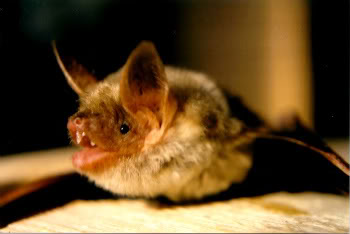|
|
Individual bats have the ability to tell the difference between other bats just by the sound of their voice, according to a study published in PLoS Computational Biology.
Researchers from the University of Tuebingen, Germany found that the greater mouse-eared bat could distinguish between their fellows’ echolocation calls. A subject bat was tested by having to select between two others depending on their calls. The subject bats chose correctly over 80 percent of the time.
 The greater mouse-eared bat is native to Europe. Photo by: Manuel Warner. |
“If you think of this in comparison with humans, it’s like being able to recognize a person just by listening to the same one-syllable yell in different voices, ” head of the study, Dr. Yossi Yovel told the BBC. “The bats learned the voice by listening to hundreds of very short ‘yells’, but they then were able to recognize an individual based on one single yell.”
Researchers then produced a computer model that reproduced the recognition behavior displayed by the bats. The model suggests that the bat’s calls contain spectral energy distribution that is unique to every individual, allowing the bats to tell one another apart simply by listening.
CITATION: Yovel Y, Melcon ML, Franz MO, Denzinger A, Schnitzler H-U (2009) The Voice of Bats: How Greater Mouse-eared Bats Recognize Individuals Based on Their Echolocation Calls. PLoS Comput Biol 5(6): e1000400.
Related articles
Fruit bats frequent clay-licks in the Amazon rainforest
(07/14/2008) In the Peru new research finds that female fruit bats are frequent visitors to clay-licks.
Fruit-eating bats ingest dirt to counter toxic plant compounds
(04/23/2008) Pregnant and lactating frugivorous bats ingest dirt in order to detoxify plant compounds in the fruit they eat, report researchers writing in the journal PLoS ONE.
Bats protect crops from insects
(04/04/2008) Bats eat as many insects at night as birds do during the day, according to research published in the journal Science.